Role of Khadijah as the Ideal Wife of Prophet Muhammad
VerifiedAdded on 2023/01/20
|8
|1883
|45
AI Summary
This paper analyzes the role of Khadijah as the ideal wife of Prophet Muhammad by shedding light on her perceptions and religious practices.
Contribute Materials
Your contribution can guide someone’s learning journey. Share your
documents today.
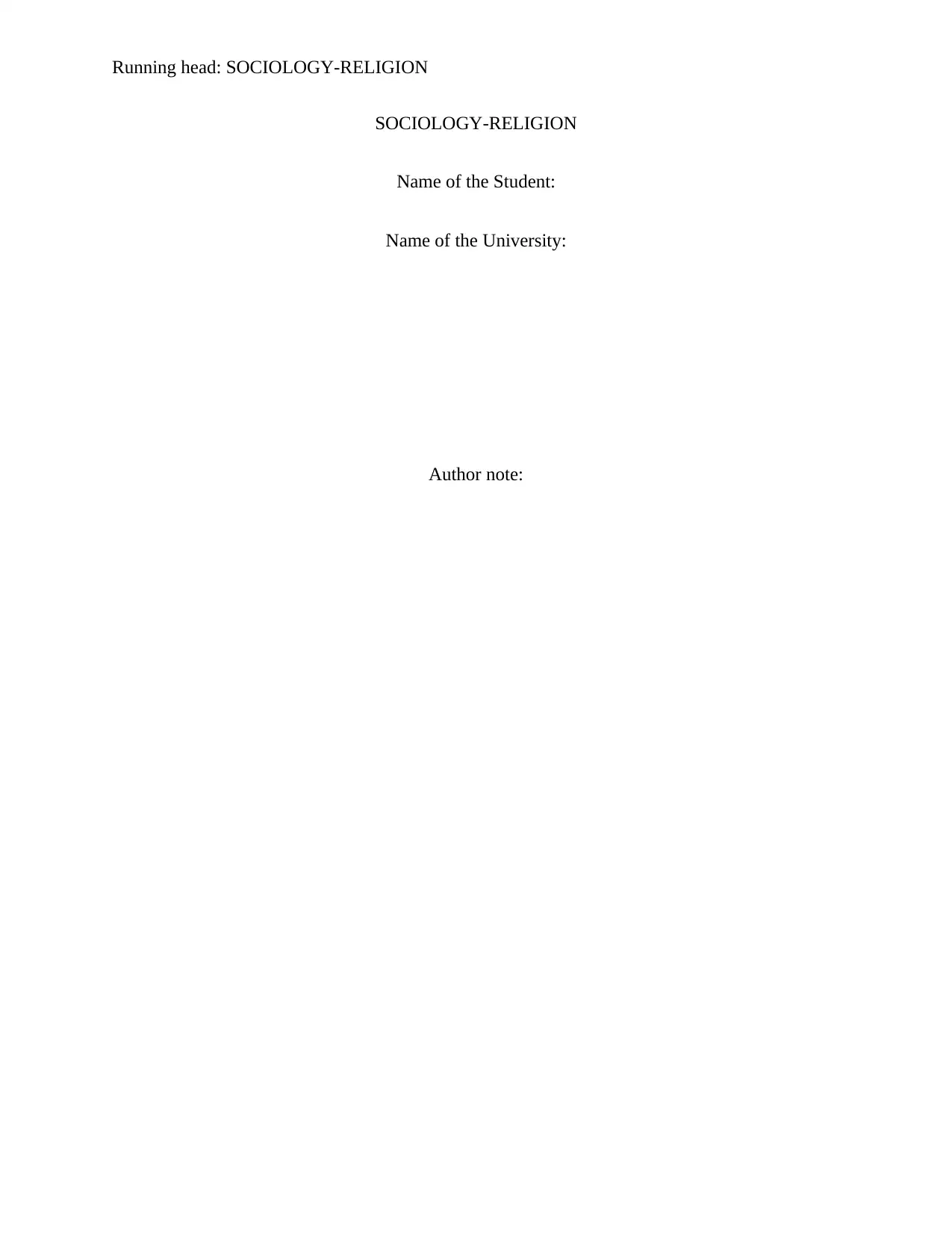
Running head: SOCIOLOGY-RELIGION
SOCIOLOGY-RELIGION
Name of the Student:
Name of the University:
Author note:
SOCIOLOGY-RELIGION
Name of the Student:
Name of the University:
Author note:
Secure Best Marks with AI Grader
Need help grading? Try our AI Grader for instant feedback on your assignments.
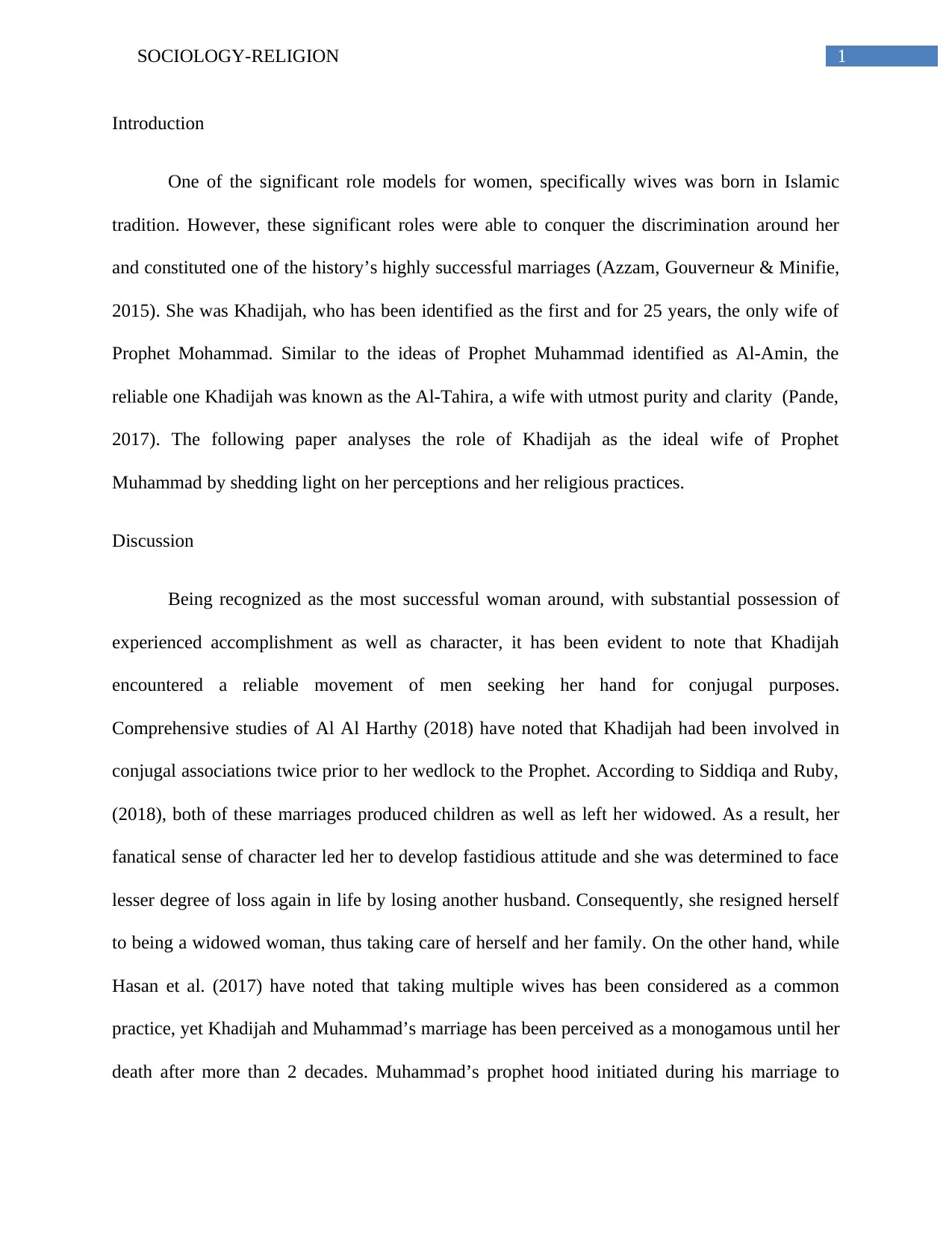
1SOCIOLOGY-RELIGION
Introduction
One of the significant role models for women, specifically wives was born in Islamic
tradition. However, these significant roles were able to conquer the discrimination around her
and constituted one of the history’s highly successful marriages (Azzam, Gouverneur & Minifie,
2015). She was Khadijah, who has been identified as the first and for 25 years, the only wife of
Prophet Mohammad. Similar to the ideas of Prophet Muhammad identified as Al-Amin, the
reliable one Khadijah was known as the Al-Tahira, a wife with utmost purity and clarity (Pande,
2017). The following paper analyses the role of Khadijah as the ideal wife of Prophet
Muhammad by shedding light on her perceptions and her religious practices.
Discussion
Being recognized as the most successful woman around, with substantial possession of
experienced accomplishment as well as character, it has been evident to note that Khadijah
encountered a reliable movement of men seeking her hand for conjugal purposes.
Comprehensive studies of Al Al Harthy (2018) have noted that Khadijah had been involved in
conjugal associations twice prior to her wedlock to the Prophet. According to Siddiqa and Ruby,
(2018), both of these marriages produced children as well as left her widowed. As a result, her
fanatical sense of character led her to develop fastidious attitude and she was determined to face
lesser degree of loss again in life by losing another husband. Consequently, she resigned herself
to being a widowed woman, thus taking care of herself and her family. On the other hand, while
Hasan et al. (2017) have noted that taking multiple wives has been considered as a common
practice, yet Khadijah and Muhammad’s marriage has been perceived as a monogamous until her
death after more than 2 decades. Muhammad’s prophet hood initiated during his marriage to
Introduction
One of the significant role models for women, specifically wives was born in Islamic
tradition. However, these significant roles were able to conquer the discrimination around her
and constituted one of the history’s highly successful marriages (Azzam, Gouverneur & Minifie,
2015). She was Khadijah, who has been identified as the first and for 25 years, the only wife of
Prophet Mohammad. Similar to the ideas of Prophet Muhammad identified as Al-Amin, the
reliable one Khadijah was known as the Al-Tahira, a wife with utmost purity and clarity (Pande,
2017). The following paper analyses the role of Khadijah as the ideal wife of Prophet
Muhammad by shedding light on her perceptions and her religious practices.
Discussion
Being recognized as the most successful woman around, with substantial possession of
experienced accomplishment as well as character, it has been evident to note that Khadijah
encountered a reliable movement of men seeking her hand for conjugal purposes.
Comprehensive studies of Al Al Harthy (2018) have noted that Khadijah had been involved in
conjugal associations twice prior to her wedlock to the Prophet. According to Siddiqa and Ruby,
(2018), both of these marriages produced children as well as left her widowed. As a result, her
fanatical sense of character led her to develop fastidious attitude and she was determined to face
lesser degree of loss again in life by losing another husband. Consequently, she resigned herself
to being a widowed woman, thus taking care of herself and her family. On the other hand, while
Hasan et al. (2017) have noted that taking multiple wives has been considered as a common
practice, yet Khadijah and Muhammad’s marriage has been perceived as a monogamous until her
death after more than 2 decades. Muhammad’s prophet hood initiated during his marriage to

2SOCIOLOGY-RELIGION
Khadijah, when he received the first of God’s disclosures through the Angel Gabriel which left
certain forms of fear and apprehension in him along with being strained and feeling alone when
none of the individuals showed faith in him. As per the studies of Fadhilah (2018), Khadijah at
this juncture comforted her husband and efficiently encouraged him during his days of challenge
and tensions.
According to the Islamic tradition, women should exhibit their utmost compassion,
affection and care towards husband. Drawing relevance to these convictions, Khadijah showed
immense love, affection and support towards Prophet Muhammad during his times of
confrontations while institutionalizing and establishing Islam (Azmi, 2014). Moreover, in the
spirit of affiliation and companionship inherent in a truthfully Islamic conjugal association, great
men as well as women showed great inclination in providing support to each other during
difficult times. Prophet Muhammad received recognition to execute several forms of household
chores associated with cleaning as well as mending clothes. Furthermore, studies conducted by
Siddiqa and Ruby (2018) have noted that Khadijah has been recognized as the first person to
acknowledge and comprehend the message of Islam and further supported her husband during
times when Prophet Muhammad faced severe opposition from his relatives and acquaintances
and also strategized to murder him.
However, as the fledgling band of Muslims gradually developed, Khadijah showed
utmost advocacy to the rise of Islam with her prosperity and health. Being an ideal wife,
Khadijah efficiently provided food, water along with medicines in support of the evicted and
boycotted community of the society. Al Al Harthy, (2018) have claimed that although Khadijah
showed no significant familiarity towards to deprivation, she never showed any form of
grievance regarding the destabilized and weakened conditions which she had been compelled to
Khadijah, when he received the first of God’s disclosures through the Angel Gabriel which left
certain forms of fear and apprehension in him along with being strained and feeling alone when
none of the individuals showed faith in him. As per the studies of Fadhilah (2018), Khadijah at
this juncture comforted her husband and efficiently encouraged him during his days of challenge
and tensions.
According to the Islamic tradition, women should exhibit their utmost compassion,
affection and care towards husband. Drawing relevance to these convictions, Khadijah showed
immense love, affection and support towards Prophet Muhammad during his times of
confrontations while institutionalizing and establishing Islam (Azmi, 2014). Moreover, in the
spirit of affiliation and companionship inherent in a truthfully Islamic conjugal association, great
men as well as women showed great inclination in providing support to each other during
difficult times. Prophet Muhammad received recognition to execute several forms of household
chores associated with cleaning as well as mending clothes. Furthermore, studies conducted by
Siddiqa and Ruby (2018) have noted that Khadijah has been recognized as the first person to
acknowledge and comprehend the message of Islam and further supported her husband during
times when Prophet Muhammad faced severe opposition from his relatives and acquaintances
and also strategized to murder him.
However, as the fledgling band of Muslims gradually developed, Khadijah showed
utmost advocacy to the rise of Islam with her prosperity and health. Being an ideal wife,
Khadijah efficiently provided food, water along with medicines in support of the evicted and
boycotted community of the society. Al Al Harthy, (2018) have claimed that although Khadijah
showed no significant familiarity towards to deprivation, she never showed any form of
grievance regarding the destabilized and weakened conditions which she had been compelled to
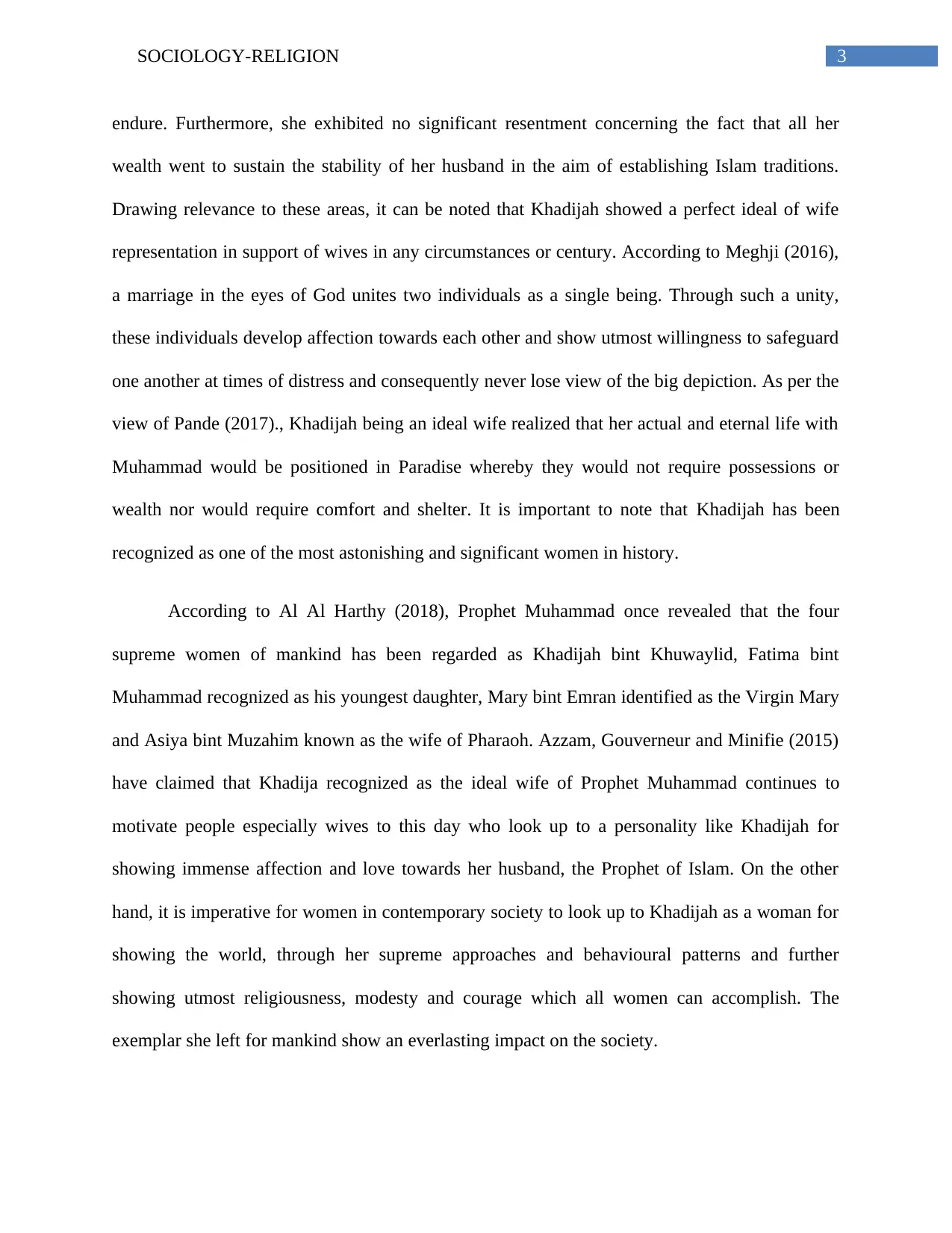
3SOCIOLOGY-RELIGION
endure. Furthermore, she exhibited no significant resentment concerning the fact that all her
wealth went to sustain the stability of her husband in the aim of establishing Islam traditions.
Drawing relevance to these areas, it can be noted that Khadijah showed a perfect ideal of wife
representation in support of wives in any circumstances or century. According to Meghji (2016),
a marriage in the eyes of God unites two individuals as a single being. Through such a unity,
these individuals develop affection towards each other and show utmost willingness to safeguard
one another at times of distress and consequently never lose view of the big depiction. As per the
view of Pande (2017)., Khadijah being an ideal wife realized that her actual and eternal life with
Muhammad would be positioned in Paradise whereby they would not require possessions or
wealth nor would require comfort and shelter. It is important to note that Khadijah has been
recognized as one of the most astonishing and significant women in history.
According to Al Al Harthy (2018), Prophet Muhammad once revealed that the four
supreme women of mankind has been regarded as Khadijah bint Khuwaylid, Fatima bint
Muhammad recognized as his youngest daughter, Mary bint Emran identified as the Virgin Mary
and Asiya bint Muzahim known as the wife of Pharaoh. Azzam, Gouverneur and Minifie (2015)
have claimed that Khadija recognized as the ideal wife of Prophet Muhammad continues to
motivate people especially wives to this day who look up to a personality like Khadijah for
showing immense affection and love towards her husband, the Prophet of Islam. On the other
hand, it is imperative for women in contemporary society to look up to Khadijah as a woman for
showing the world, through her supreme approaches and behavioural patterns and further
showing utmost religiousness, modesty and courage which all women can accomplish. The
exemplar she left for mankind show an everlasting impact on the society.
endure. Furthermore, she exhibited no significant resentment concerning the fact that all her
wealth went to sustain the stability of her husband in the aim of establishing Islam traditions.
Drawing relevance to these areas, it can be noted that Khadijah showed a perfect ideal of wife
representation in support of wives in any circumstances or century. According to Meghji (2016),
a marriage in the eyes of God unites two individuals as a single being. Through such a unity,
these individuals develop affection towards each other and show utmost willingness to safeguard
one another at times of distress and consequently never lose view of the big depiction. As per the
view of Pande (2017)., Khadijah being an ideal wife realized that her actual and eternal life with
Muhammad would be positioned in Paradise whereby they would not require possessions or
wealth nor would require comfort and shelter. It is important to note that Khadijah has been
recognized as one of the most astonishing and significant women in history.
According to Al Al Harthy (2018), Prophet Muhammad once revealed that the four
supreme women of mankind has been regarded as Khadijah bint Khuwaylid, Fatima bint
Muhammad recognized as his youngest daughter, Mary bint Emran identified as the Virgin Mary
and Asiya bint Muzahim known as the wife of Pharaoh. Azzam, Gouverneur and Minifie (2015)
have claimed that Khadija recognized as the ideal wife of Prophet Muhammad continues to
motivate people especially wives to this day who look up to a personality like Khadijah for
showing immense affection and love towards her husband, the Prophet of Islam. On the other
hand, it is imperative for women in contemporary society to look up to Khadijah as a woman for
showing the world, through her supreme approaches and behavioural patterns and further
showing utmost religiousness, modesty and courage which all women can accomplish. The
exemplar she left for mankind show an everlasting impact on the society.
Secure Best Marks with AI Grader
Need help grading? Try our AI Grader for instant feedback on your assignments.
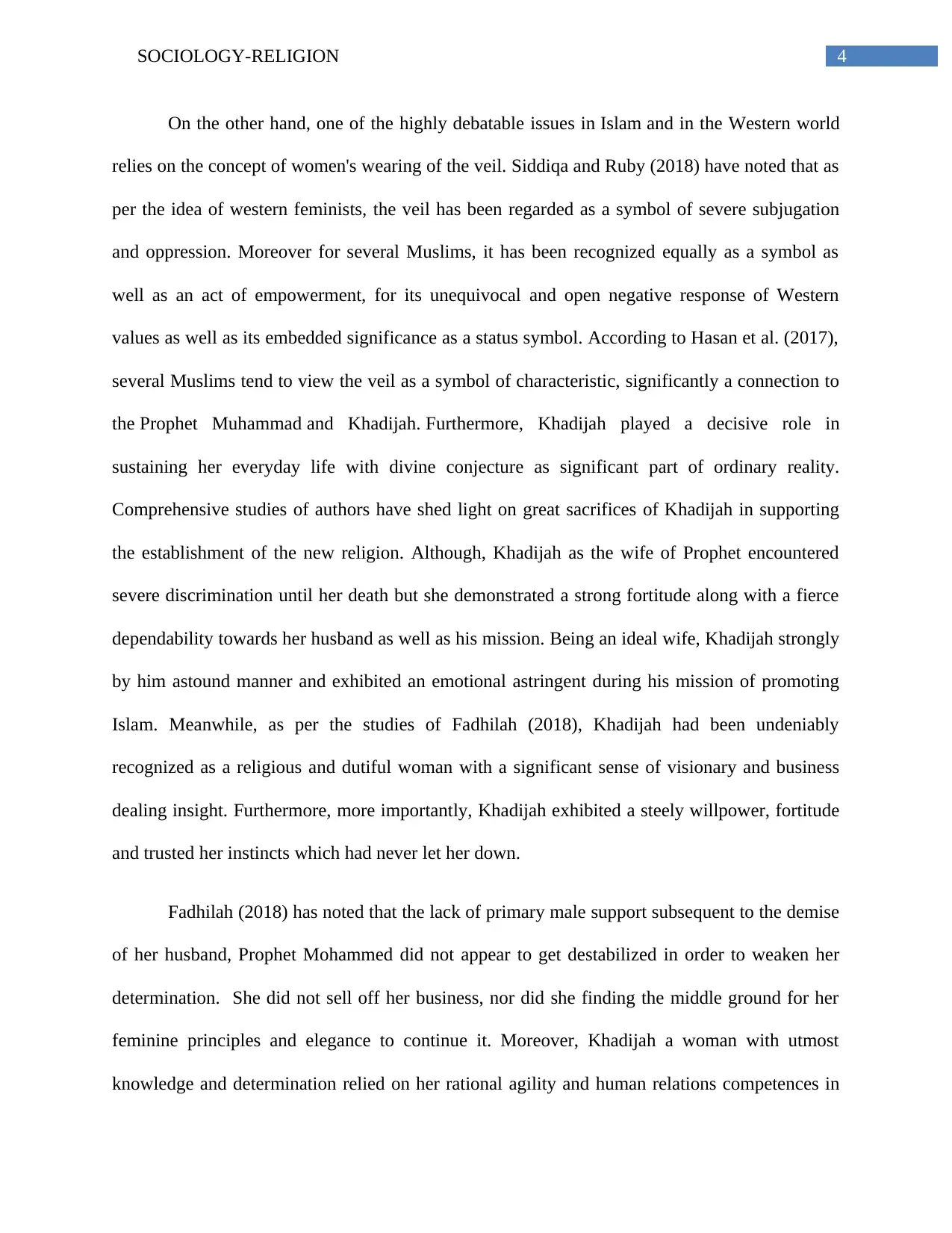
4SOCIOLOGY-RELIGION
On the other hand, one of the highly debatable issues in Islam and in the Western world
relies on the concept of women's wearing of the veil. Siddiqa and Ruby (2018) have noted that as
per the idea of western feminists, the veil has been regarded as a symbol of severe subjugation
and oppression. Moreover for several Muslims, it has been recognized equally as a symbol as
well as an act of empowerment, for its unequivocal and open negative response of Western
values as well as its embedded significance as a status symbol. According to Hasan et al. (2017),
several Muslims tend to view the veil as a symbol of characteristic, significantly a connection to
the Prophet Muhammad and Khadijah. Furthermore, Khadijah played a decisive role in
sustaining her everyday life with divine conjecture as significant part of ordinary reality.
Comprehensive studies of authors have shed light on great sacrifices of Khadijah in supporting
the establishment of the new religion. Although, Khadijah as the wife of Prophet encountered
severe discrimination until her death but she demonstrated a strong fortitude along with a fierce
dependability towards her husband as well as his mission. Being an ideal wife, Khadijah strongly
by him astound manner and exhibited an emotional astringent during his mission of promoting
Islam. Meanwhile, as per the studies of Fadhilah (2018), Khadijah had been undeniably
recognized as a religious and dutiful woman with a significant sense of visionary and business
dealing insight. Furthermore, more importantly, Khadijah exhibited a steely willpower, fortitude
and trusted her instincts which had never let her down.
Fadhilah (2018) has noted that the lack of primary male support subsequent to the demise
of her husband, Prophet Mohammed did not appear to get destabilized in order to weaken her
determination. She did not sell off her business, nor did she finding the middle ground for her
feminine principles and elegance to continue it. Moreover, Khadijah a woman with utmost
knowledge and determination relied on her rational agility and human relations competences in
On the other hand, one of the highly debatable issues in Islam and in the Western world
relies on the concept of women's wearing of the veil. Siddiqa and Ruby (2018) have noted that as
per the idea of western feminists, the veil has been regarded as a symbol of severe subjugation
and oppression. Moreover for several Muslims, it has been recognized equally as a symbol as
well as an act of empowerment, for its unequivocal and open negative response of Western
values as well as its embedded significance as a status symbol. According to Hasan et al. (2017),
several Muslims tend to view the veil as a symbol of characteristic, significantly a connection to
the Prophet Muhammad and Khadijah. Furthermore, Khadijah played a decisive role in
sustaining her everyday life with divine conjecture as significant part of ordinary reality.
Comprehensive studies of authors have shed light on great sacrifices of Khadijah in supporting
the establishment of the new religion. Although, Khadijah as the wife of Prophet encountered
severe discrimination until her death but she demonstrated a strong fortitude along with a fierce
dependability towards her husband as well as his mission. Being an ideal wife, Khadijah strongly
by him astound manner and exhibited an emotional astringent during his mission of promoting
Islam. Meanwhile, as per the studies of Fadhilah (2018), Khadijah had been undeniably
recognized as a religious and dutiful woman with a significant sense of visionary and business
dealing insight. Furthermore, more importantly, Khadijah exhibited a steely willpower, fortitude
and trusted her instincts which had never let her down.
Fadhilah (2018) has noted that the lack of primary male support subsequent to the demise
of her husband, Prophet Mohammed did not appear to get destabilized in order to weaken her
determination. She did not sell off her business, nor did she finding the middle ground for her
feminine principles and elegance to continue it. Moreover, Khadijah a woman with utmost
knowledge and determination relied on her rational agility and human relations competences in
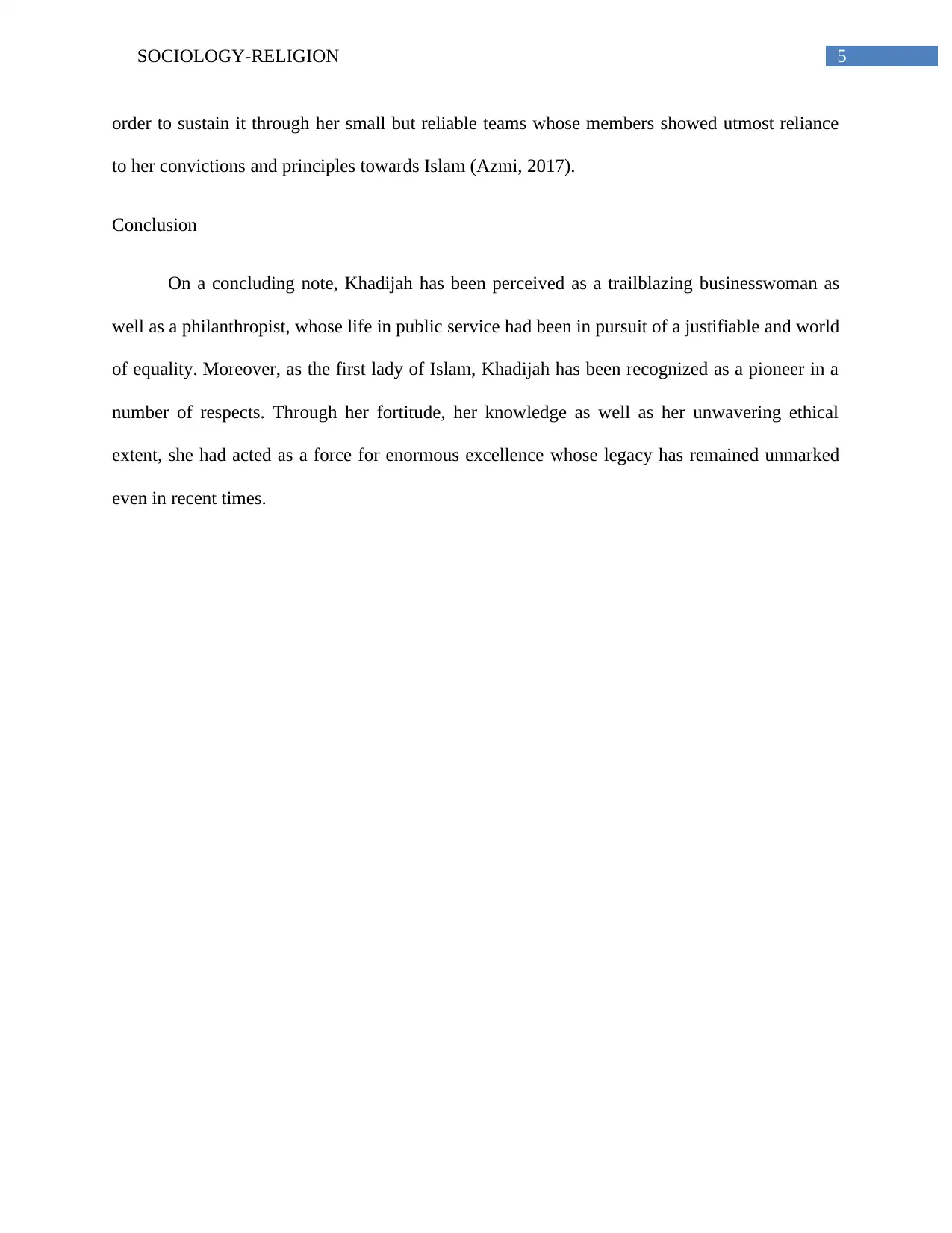
5SOCIOLOGY-RELIGION
order to sustain it through her small but reliable teams whose members showed utmost reliance
to her convictions and principles towards Islam (Azmi, 2017).
Conclusion
On a concluding note, Khadijah has been perceived as a trailblazing businesswoman as
well as a philanthropist, whose life in public service had been in pursuit of a justifiable and world
of equality. Moreover, as the first lady of Islam, Khadijah has been recognized as a pioneer in a
number of respects. Through her fortitude, her knowledge as well as her unwavering ethical
extent, she had acted as a force for enormous excellence whose legacy has remained unmarked
even in recent times.
order to sustain it through her small but reliable teams whose members showed utmost reliance
to her convictions and principles towards Islam (Azmi, 2017).
Conclusion
On a concluding note, Khadijah has been perceived as a trailblazing businesswoman as
well as a philanthropist, whose life in public service had been in pursuit of a justifiable and world
of equality. Moreover, as the first lady of Islam, Khadijah has been recognized as a pioneer in a
number of respects. Through her fortitude, her knowledge as well as her unwavering ethical
extent, she had acted as a force for enormous excellence whose legacy has remained unmarked
even in recent times.
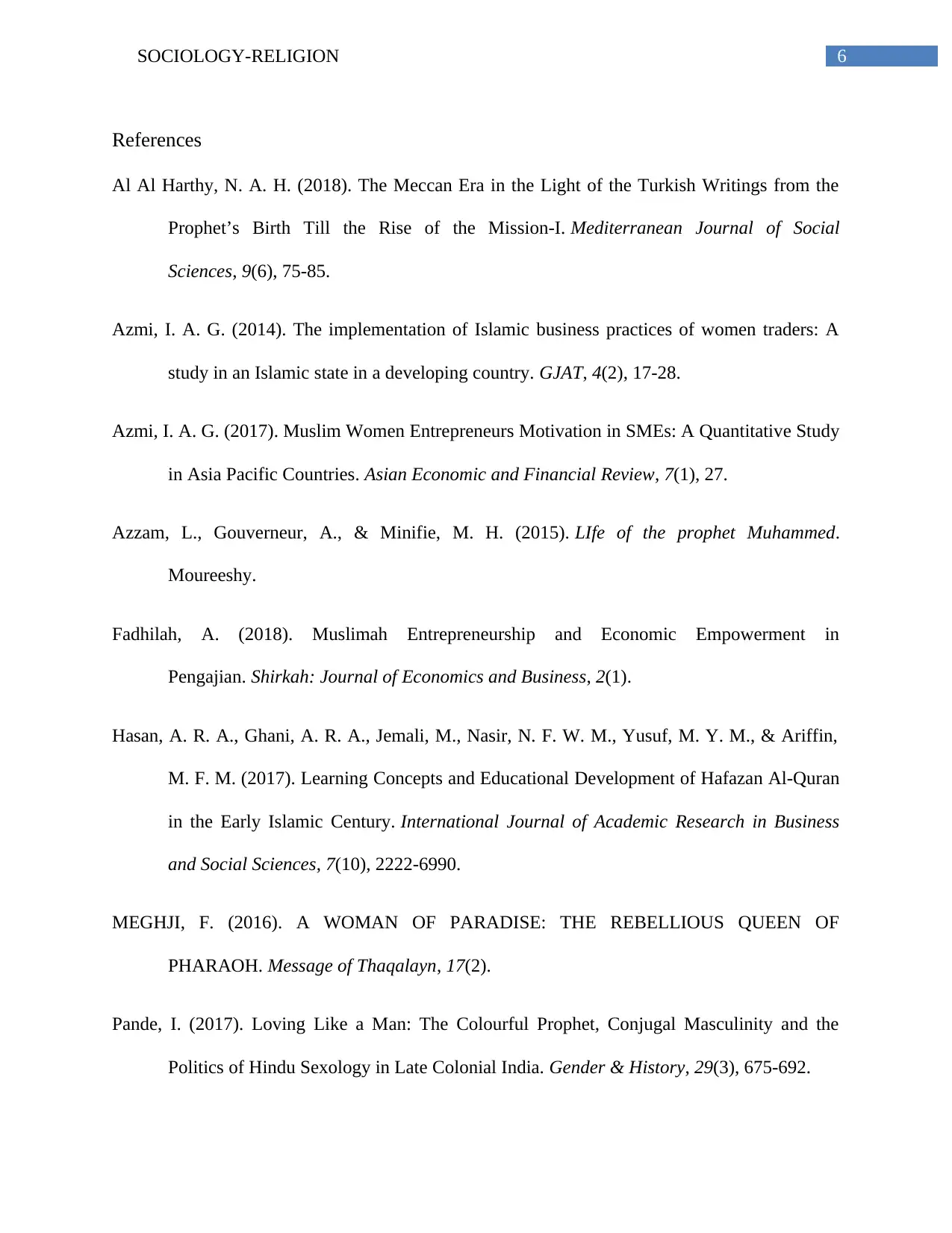
6SOCIOLOGY-RELIGION
References
Al Al Harthy, N. A. H. (2018). The Meccan Era in the Light of the Turkish Writings from the
Prophet’s Birth Till the Rise of the Mission-I. Mediterranean Journal of Social
Sciences, 9(6), 75-85.
Azmi, I. A. G. (2014). The implementation of Islamic business practices of women traders: A
study in an Islamic state in a developing country. GJAT, 4(2), 17-28.
Azmi, I. A. G. (2017). Muslim Women Entrepreneurs Motivation in SMEs: A Quantitative Study
in Asia Pacific Countries. Asian Economic and Financial Review, 7(1), 27.
Azzam, L., Gouverneur, A., & Minifie, M. H. (2015). LIfe of the prophet Muhammed.
Moureeshy.
Fadhilah, A. (2018). Muslimah Entrepreneurship and Economic Empowerment in
Pengajian. Shirkah: Journal of Economics and Business, 2(1).
Hasan, A. R. A., Ghani, A. R. A., Jemali, M., Nasir, N. F. W. M., Yusuf, M. Y. M., & Ariffin,
M. F. M. (2017). Learning Concepts and Educational Development of Hafazan Al-Quran
in the Early Islamic Century. International Journal of Academic Research in Business
and Social Sciences, 7(10), 2222-6990.
MEGHJI, F. (2016). A WOMAN OF PARADISE: THE REBELLIOUS QUEEN OF
PHARAOH. Message of Thaqalayn, 17(2).
Pande, I. (2017). Loving Like a Man: The Colourful Prophet, Conjugal Masculinity and the
Politics of Hindu Sexology in Late Colonial India. Gender & History, 29(3), 675-692.
References
Al Al Harthy, N. A. H. (2018). The Meccan Era in the Light of the Turkish Writings from the
Prophet’s Birth Till the Rise of the Mission-I. Mediterranean Journal of Social
Sciences, 9(6), 75-85.
Azmi, I. A. G. (2014). The implementation of Islamic business practices of women traders: A
study in an Islamic state in a developing country. GJAT, 4(2), 17-28.
Azmi, I. A. G. (2017). Muslim Women Entrepreneurs Motivation in SMEs: A Quantitative Study
in Asia Pacific Countries. Asian Economic and Financial Review, 7(1), 27.
Azzam, L., Gouverneur, A., & Minifie, M. H. (2015). LIfe of the prophet Muhammed.
Moureeshy.
Fadhilah, A. (2018). Muslimah Entrepreneurship and Economic Empowerment in
Pengajian. Shirkah: Journal of Economics and Business, 2(1).
Hasan, A. R. A., Ghani, A. R. A., Jemali, M., Nasir, N. F. W. M., Yusuf, M. Y. M., & Ariffin,
M. F. M. (2017). Learning Concepts and Educational Development of Hafazan Al-Quran
in the Early Islamic Century. International Journal of Academic Research in Business
and Social Sciences, 7(10), 2222-6990.
MEGHJI, F. (2016). A WOMAN OF PARADISE: THE REBELLIOUS QUEEN OF
PHARAOH. Message of Thaqalayn, 17(2).
Pande, I. (2017). Loving Like a Man: The Colourful Prophet, Conjugal Masculinity and the
Politics of Hindu Sexology in Late Colonial India. Gender & History, 29(3), 675-692.
Paraphrase This Document
Need a fresh take? Get an instant paraphrase of this document with our AI Paraphraser
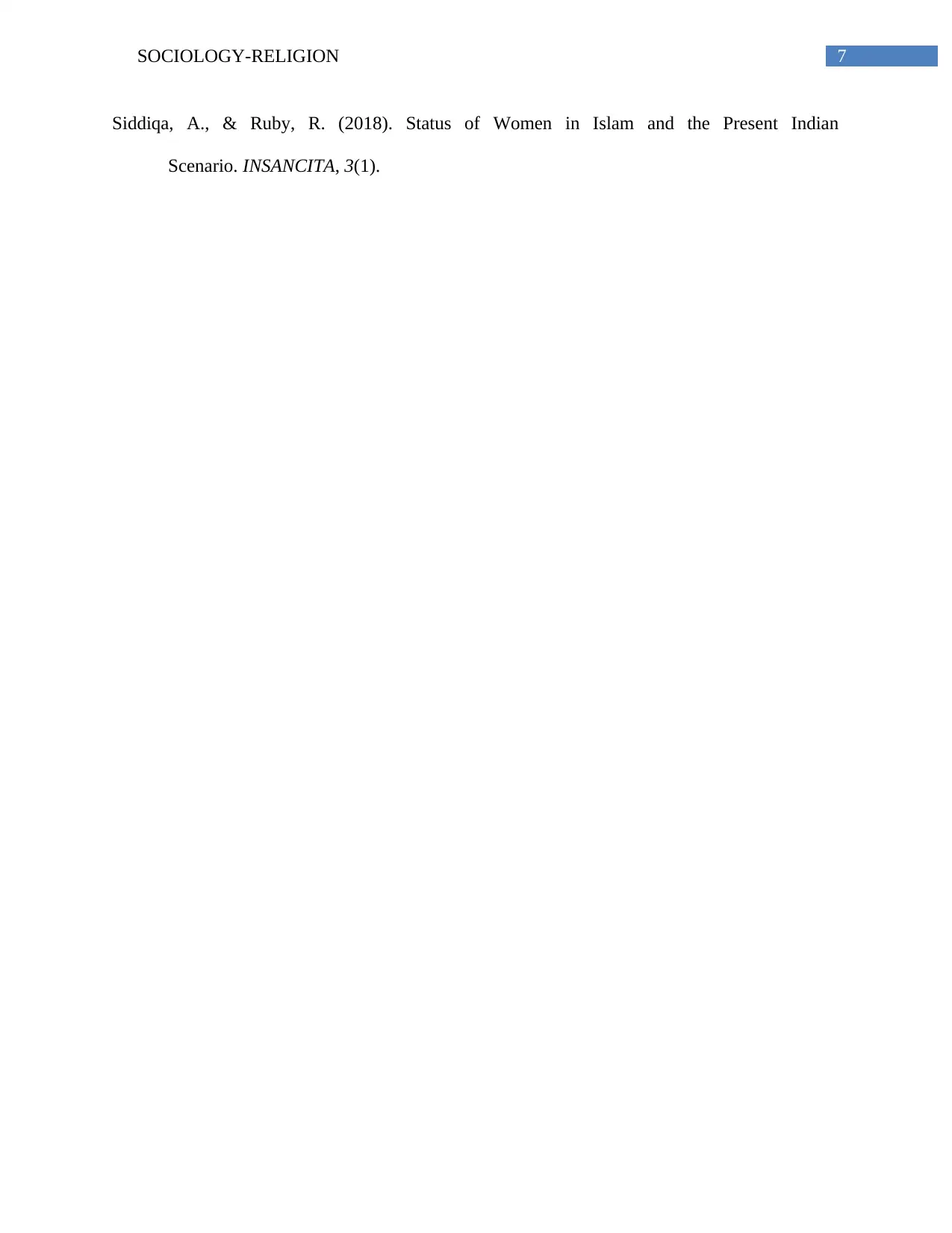
7SOCIOLOGY-RELIGION
Siddiqa, A., & Ruby, R. (2018). Status of Women in Islam and the Present Indian
Scenario. INSANCITA, 3(1).
Siddiqa, A., & Ruby, R. (2018). Status of Women in Islam and the Present Indian
Scenario. INSANCITA, 3(1).
1 out of 8
Your All-in-One AI-Powered Toolkit for Academic Success.
+13062052269
info@desklib.com
Available 24*7 on WhatsApp / Email
![[object Object]](/_next/static/media/star-bottom.7253800d.svg)
Unlock your academic potential
© 2024 | Zucol Services PVT LTD | All rights reserved.


